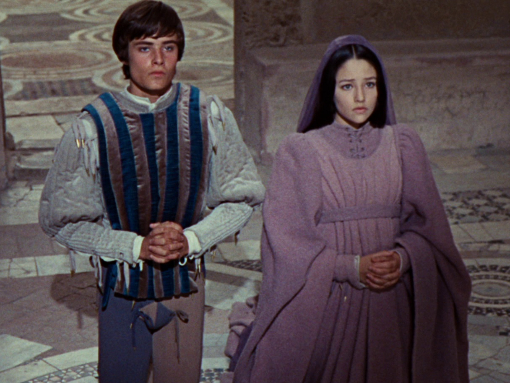Romeo and Juliet

See more details, packaging, or compare
Synopsis
One of the great Shakespeare adaptations, this sublime take on the Bard’s immortal romantic tragedy by Franco Zeffirelli breathed new life into the oft-told tale by casting actual teenagers in the title roles. As the young lovers whose affair threatens to inflame the tensions between their feuding families in Renaissance Verona, Olivia Hussey and Leonard Whiting vividly capture the mix of adolescent ardor and turmoil that fuels their destiny-driven liaison. A sensory banquet thanks to Nino Rota’s delicate score and the exquisite, Oscar-winning costumes and cinematography, Romeo and Juliet is Shakespeare at its most deeply felt and passionately alive.
Picture 8/10
Franco Zeffirelli’s Romeo and Juliet—one of the more popular film adaptations of the Bard’s work—receives an all-new special edition Blu-ray from The Criterion Collection and is presented on a dual-layer disc in its original aspect ratio of 1.85:1. The 1080p/24hz high-definition presentation comes from a new 4K restoration taken primarily from the 35mm original Eastmancolor negative. The 35mm separation masters were used to fill in for damaged sections.
The new restoration and end presentation significantly improve upon Paramount’s previous DVD edition. The new scan has picked up an incredible level of detail, the textures of the costumes leaping out now, same with the courtyard's stone walls and other settings. The colors look decent, limited a bit by the Eastmancolor source and what looks to be a bit of a teal push at times, but skin tones and whites still look strong alongside nice pops of blue, red, and orange. Black levels are inky with wide range in the shadows, though some day-for-night shots can look a little flat with a bit of crush that could be baked into the photography.
The film is quite grainy, and it’s rendered well enough here. There are times when subtle blocky patterns can pop up, or there’s a bit of a mushy look to it, but on the whole I thought the image retained a nice photographic look. The restoration has cleaned things up wonderfully, and there are no severe issues outside of a handful of dupier-looking shots—slightly softer, grain a little messier—that probably come from the alternate source.
Slight hiccups aside, it’s a very nice-looking image, and the new presentation is well worth the upgrade.








































Audio 7/10
Criterion includes the film’s original monaural soundtrack here in lossless single-channel PCM. It’s a sharp-sounding presentation with decent range and no notable damage. Music also shows impressive highs without cracking, and dialogue sounds clear and easy to hear, as one would hope for Shakespeare.
Extras 4/10
The film receives a pretty light set of features, all archival. There’s a 5-minute excerpt from the documentary Franco Zeffirelli: Directing from Life that—after opening with footage from the premiere of his The Taming of the Shrew—covers the making of his dream project, Romeo and Juliet, with his adopted son Pippo Zeffirelli popping up to talk a bit about him.
Sadly, that’s about the extent of any material around Zeffirelli himself, Criterion unable or unwilling to include the whole documentary or any other material about the director. Also, as a look into the making of the film, the excerpt reveals very little. In this latter area, two interviews with actors Olivia Hussey and Leonard Whiting—one recorded in 1967 and the other in 2016 for the BFI—cover things more satisfactorily. The 2016 one, running 33 minutes and filmed around a screening, gets more into the nitty-gritty of the production, the two recalling how Zeffirelli worked and the atmosphere on-set with some detail around Nino Rota’s score. Interestingly, Whiting talks about material cut from the film, including other essential characters in the play, with Zeffirelli telling him his best performance ended up on the cutting room floor. They do talk about the nude scene, though they seem optimistic about it, and also fondly recall the overall experience of working together. I sometimes felt Whiting was trying to keep the spotlight on him throughout the discussion, which felt awkward (I could also be misreading everything), but on the whole, it’s not a bad reflection on the film.
The 1967 interview (from the raw footage) doesn’t add a lot on top of that, though it still proves interesting to watch, if only because Hussey mentions the experience in the 2016 one, particularly the moment where she pulls out a cigarette, horrifying the Paramount executives that were there (and yes, she puffs away here). The questions focus on their young age, previous experience, and where they see their careers going. It’s charming, though there is a sense that the two are a bit unsure or annoyed by the questions, which is fair. It’s also worth noting that this interview was included in BFI’s edition of All the Right Noises, which also starred Hussey.
Ramona Wray, professor of Shakespeare and Early Modern Literature at Queen’s University Belfast, looks at Zeffirelli’s knack for adapting the Bard’s work, marking the extent of academic material here. Oddly, Criterion doesn’t include anything else, doesn’t offer any feature that explores the adaptation, nothing that looks at Shakespeare adaptations in general, and next-to-nothing about the filmmaker himself. It’s a missed opportunity, especially since the film has never received any special edition before this.
Closing
It’s disappointingly slim in features, but the new restoration and end presentation look excellent.




